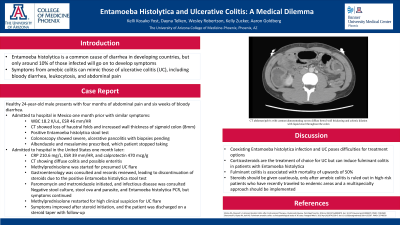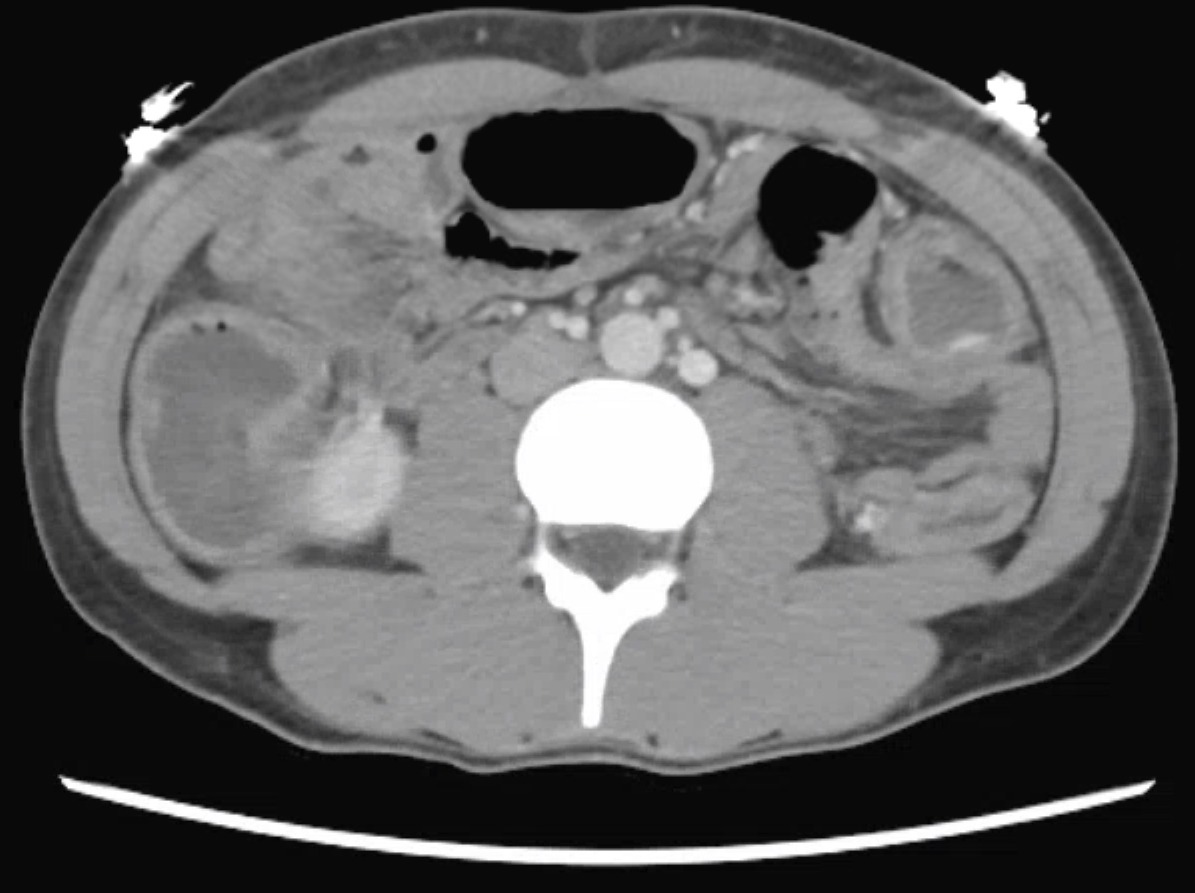Monday Poster Session
Category: IBD
P2258 - Entamoeba Histolytica and Ulcerative Colitis: A Medical Dilemma
Monday, October 23, 2023
10:30 AM - 4:15 PM PT
Location: Exhibit Hall

Has Audio

Kelli Kosako Yost, MD
University of Arizona College of Medicine
Phoenix, AZ
Presenting Author(s)
Kelli Kosako Yost, MD1, Dayna Telken, DO1, Wesley A.. Robertson, MD, MPH, MPA1, Kelly Zucker, DO1, Aaron Goldberg, MD2
1University of Arizona College of Medicine, Phoenix, AZ; 2Carl T. Hayden Veterans Affairs Medical Center, Phoenix, AZ
Introduction: Entamoeba histolytica is a common cause of diarrhea in developing countries, but only around 10% of those infected will go on to develop symptoms. Symptoms from amebic colitis can mimic those of ulcerative colitis (UC), including bloody diarrhea, leukocytosis, and abdominal pain.
Case Description/Methods: The patient is a healthy 24-year-old male who presented with four months of abdominal pain and six weeks of bloody diarrhea. He frequently travels to Mexico, and one month prior to presentation he was admitted to a hospital in Mexico for these symptoms. At that time, CT abdomen and pelvis showed loss of haustral folds and increased wall thickness of sigmoid colon (8mm) with labs significant for WBC 18.2 K/uL, ESR 46 mm/hr, and positive Entamoeba histolytica stool test. Colonoscopy showed severe, ulcerative pancolitis with biopsies taken and results pending. One dose of albendazole was given and the patient was started on mesalamine, which he stopped shortly after due to continued symptoms. One month later, he presented to our hospital with similar symptoms, meeting SIRS criteria with an elevated heart rate (126 bpm), fever (102.7 F), and leukocytosis (18.4 K/uL). Labs revealed CRP 210.6 mg/L, ESR 39 mm/hr, and calprotectin 470 mcg/g. CT abdomen and pelvis with contrast demonstrated diffuse colitis and possible enteritis. Methylprednisolone was started for presumed UC flare. Gastroenterology was consulted, and after a review of outside records, steroids were discontinued due to the recent positive Entamoeba histolytica stool test. Paromomycin and metronidazole were started and infectious disease was consulted. Stool ova and parasite and culture were negative. Despite therapy for several days, he continued to have bloody diarrhea. PCR for Entamoeba histolytica eventually resulted as negative. He was then restarted on methylprednisolone for high clinical suspicion for UC flare. The pain and bloody diarrhea improved and the patient was discharged with a steroid taper with gastroenterology follow-up.
Discussion: Coexisting Entamoeba histolytica infection and UC pose difficulty in selecting treatment options. Although corticosteroids are the treatment of choice for UC, they can induce fulminant colitis in patients with Entamoeba histolytica, associated with mortality upwards of 50%. Steroids should be given cautiously, only after amebic colitis is ruled out in high-risk patients who have recently traveled to endemic areas and a multispecialty approach should be implemented.

Disclosures:
Kelli Kosako Yost, MD1, Dayna Telken, DO1, Wesley A.. Robertson, MD, MPH, MPA1, Kelly Zucker, DO1, Aaron Goldberg, MD2. P2258 - Entamoeba Histolytica and Ulcerative Colitis: A Medical Dilemma, ACG 2023 Annual Scientific Meeting Abstracts. Vancouver, BC, Canada: American College of Gastroenterology.
1University of Arizona College of Medicine, Phoenix, AZ; 2Carl T. Hayden Veterans Affairs Medical Center, Phoenix, AZ
Introduction: Entamoeba histolytica is a common cause of diarrhea in developing countries, but only around 10% of those infected will go on to develop symptoms. Symptoms from amebic colitis can mimic those of ulcerative colitis (UC), including bloody diarrhea, leukocytosis, and abdominal pain.
Case Description/Methods: The patient is a healthy 24-year-old male who presented with four months of abdominal pain and six weeks of bloody diarrhea. He frequently travels to Mexico, and one month prior to presentation he was admitted to a hospital in Mexico for these symptoms. At that time, CT abdomen and pelvis showed loss of haustral folds and increased wall thickness of sigmoid colon (8mm) with labs significant for WBC 18.2 K/uL, ESR 46 mm/hr, and positive Entamoeba histolytica stool test. Colonoscopy showed severe, ulcerative pancolitis with biopsies taken and results pending. One dose of albendazole was given and the patient was started on mesalamine, which he stopped shortly after due to continued symptoms. One month later, he presented to our hospital with similar symptoms, meeting SIRS criteria with an elevated heart rate (126 bpm), fever (102.7 F), and leukocytosis (18.4 K/uL). Labs revealed CRP 210.6 mg/L, ESR 39 mm/hr, and calprotectin 470 mcg/g. CT abdomen and pelvis with contrast demonstrated diffuse colitis and possible enteritis. Methylprednisolone was started for presumed UC flare. Gastroenterology was consulted, and after a review of outside records, steroids were discontinued due to the recent positive Entamoeba histolytica stool test. Paromomycin and metronidazole were started and infectious disease was consulted. Stool ova and parasite and culture were negative. Despite therapy for several days, he continued to have bloody diarrhea. PCR for Entamoeba histolytica eventually resulted as negative. He was then restarted on methylprednisolone for high clinical suspicion for UC flare. The pain and bloody diarrhea improved and the patient was discharged with a steroid taper with gastroenterology follow-up.
Discussion: Coexisting Entamoeba histolytica infection and UC pose difficulty in selecting treatment options. Although corticosteroids are the treatment of choice for UC, they can induce fulminant colitis in patients with Entamoeba histolytica, associated with mortality upwards of 50%. Steroids should be given cautiously, only after amebic colitis is ruled out in high-risk patients who have recently traveled to endemic areas and a multispecialty approach should be implemented.

Figure: CT abdomen/pelvis with contrast demonstrating severe diffuse bowel wall thickening and colonic dilation with liquid stool throughout the colon
Disclosures:
Kelli Kosako Yost indicated no relevant financial relationships.
Dayna Telken indicated no relevant financial relationships.
Wesley Robertson indicated no relevant financial relationships.
Kelly Zucker indicated no relevant financial relationships.
Aaron Goldberg indicated no relevant financial relationships.
Kelli Kosako Yost, MD1, Dayna Telken, DO1, Wesley A.. Robertson, MD, MPH, MPA1, Kelly Zucker, DO1, Aaron Goldberg, MD2. P2258 - Entamoeba Histolytica and Ulcerative Colitis: A Medical Dilemma, ACG 2023 Annual Scientific Meeting Abstracts. Vancouver, BC, Canada: American College of Gastroenterology.
